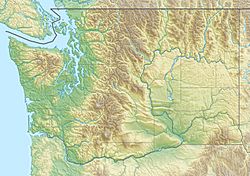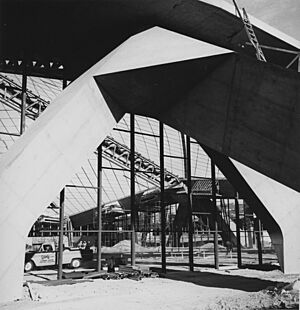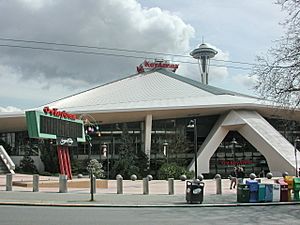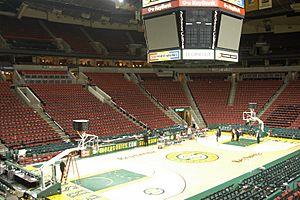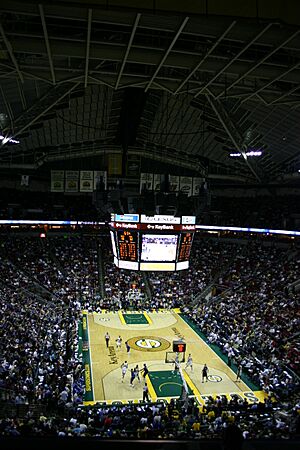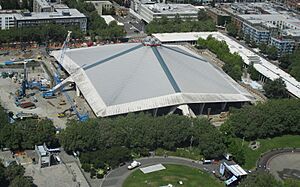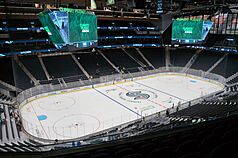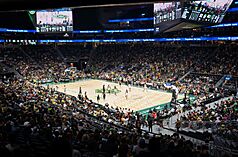Climate Pledge Arena facts for kids
 |
|
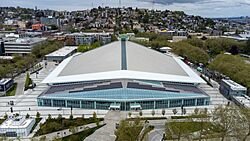
Aerial view from south in 2022
|
|
| Full name | Climate Pledge Arena at Seattle Center |
|---|---|
| Former names |
|
| Address | 334 1st Avenue N. |
| Location | Seattle, Washington, U.S. |
| Coordinates | 47°37′19″N 122°21′14″W / 47.622°N 122.354°W |
| Public transit | |
| Owner | City of Seattle |
| Operator | Oak View Group |
| Capacity | Basketball: 18,300 Concerts: 17,200 Ice hockey: 17,151 |
| Construction | |
| Broke ground | May 12, 1960 |
| Opened | April 21, 1962 |
| Renovated | 1964, 1994–95, 2018–21 |
| Reopened | October 26, 1995 (as KeyArena) October 19, 2021 (as Climate Pledge Arena) |
| Construction cost | $7 million (1962) ($69.2 million in 2022 dollars ) $74.5 million (1995) ($147 million in 2022 dollars ) $1.15 billion (2021) |
| Architect | Paul A. Thiry (1962) NBBJ (1995) Populous (2021) |
| Project manager | CAA ICON (2021) |
| Structural engineer | Peter H. Hostmark and Associates (1962) Skilling Ward Magnusson Barkshire (1995) Thornton Tomasetti (2021) |
| General contractor | Howard S. Wright Construction (1962) PCL Construction (1995) Mortenson Construction (2021) |
| Tenants | |
| Seattle Kraken (NHL) (2021–present) Seattle Redhawks (NCAA) (1964–1980, 2008–2018, 2021–present) Seattle Storm (WNBA) (2000–2018, 2022–present) Seattle Totems (WHL/CHL) (1964–1975) Seattle SuperSonics (NBA) (1967–1978, 1985–1994, 1995–2008) Seattle Thunderbirds (WHL) (1989–2008) Seattle SeaDogs (CISL) (1996–1997) Washington Huskies (NCAA) (1999–2000) Rat City Roller Derby (WFTDA) (2009–2018) Coachella Valley Firebirds (AHL) (2022) PWHL Seattle (PWHL) (2025–present) |
|
|
Century 21–Washington State Coliseum
|
|
| Location |
|
| Area | approx. 6.8 acres (2.8 ha) |
| Architectural style | Modern |
| NRHP reference No. | 100002406 |
| Significant dates | |
| Added to NRHP | May 10, 2018 |
Climate Pledge Arena is a cool indoor stadium in Seattle, Washington. It's a place where many different events happen. You can find it in the Seattle Center, a big entertainment area. This area was once home to the 1962 World's Fair.
The arena first opened in 1962. It has been updated and changed a few times since then. From 2018 to 2021, it got a huge makeover. This renovation cost about $1.15 billion. The outside of the building and its famous roof were kept. These parts are even protected as a special Seattle Landmark.
Today, Climate Pledge Arena is home to several sports teams. These include the Seattle Kraken (ice hockey), the Seattle Storm (women's basketball), and PWHL Seattle (women's hockey). The Seattle University Redhawks men's basketball team also plays here. It's even home to the Rat City Roller Derby league. The arena can hold over 17,000 fans for hockey and over 18,000 for basketball. It is the oldest arena in the NHL.
This arena was once known as the Seattle Center Coliseum. It was the home of the Seattle SuperSonics basketball team for many years. The SuperSonics played there from 1967 to 1978, and again from 1985 to 1994. After a big renovation in 1995, it was renamed KeyArena. This was because KeyCorp bought the rights to the name. The SuperSonics left Seattle in 2008.
In 2020, Amazon bought the naming rights. They named it Climate Pledge Arena. This name helps bring attention to climate change. It supports a promise for businesses to become carbon neutral by 2040.
Contents
Arena History
The Original Seattle Center Coliseum
The arena first opened in 1962. It was called the Washington State Pavilion for the Century 21 Exposition, also known as the World's Fair. A famous architect named Paul Thiry designed it. After the fair, the city of Seattle bought the building. They spent $2.9 million to turn it into the Washington State Coliseum.
The newly updated Coliseum became a main part of the Seattle Center. The Seattle University men's basketball team was the first major team to play there. In 1964, the building was renamed the Seattle Center Coliseum. The Seattle Totems hockey team also moved in that year.
The Seattle SuperSonics basketball team started playing there in 1967. They stayed for most of their time in Seattle. The Coliseum hosted two NBA Finals in 1978 and 1979. The SuperSonics won their only championship in 1979.
Sometimes, the SuperSonics played games at the larger Kingdome stadium. This happened when the Coliseum was busy. The arena also hosted the NBA All-Star Game in 1974. In 1987, it hosted some All-Star events, like the Slam Dunk Contest.
In 1986, a basketball game was even stopped because of rain leaking from the roof! This showed that the arena needed some serious updates.
Becoming KeyArena
Seattle's mayor, Norm Rice, worried that the city might lose the SuperSonics. He also wanted a more modern place for concerts. So, the city decided to renovate the Coliseum. The plan was to dig the floor deeper to add more seats. They also wanted to keep the original roof, which saved a lot of money.
The renovation cost about $73.4 million. The city and the SuperSonics agreed to share the money earned from the arena. This was a new way to pay for a stadium. The idea was that the arena would pay for itself.
The Coliseum closed for a year for the renovation. During this time, the SuperSonics played in Tacoma. Construction started in June 1994. The local company NBBJ was the architect.
On April 11, 1995, KeyBank bought the naming rights. The Coliseum was renamed KeyArena. The renovation made the arena much better. It had new concession stands, luxury suites, and more seats. The court was lowered 35 feet below street level. This allowed for 3,000 more seats.
The new KeyArena opened on October 26, 1995. The SuperSonics played their first game there on November 4, 1995. They even made it to the 1996 NBA Finals in their first season in the new arena.
The SuperSonics Leave Seattle
In 2001, the SuperSonics team was sold to a new owner, Howard Schultz. He said the team was losing a lot of money. He wanted the city to help pay for a new arena. But the city and the team couldn't agree.
Schultz then decided to sell the team. He sold it to a group from Oklahoma City in 2006. This group wanted to move the team. Many people in Seattle tried to keep the team. They even filed a lawsuit.
In 2008, the team and the city reached an agreement. The team paid Seattle $45 million to break its lease early. They also agreed to pay another $30 million if Seattle didn't get a new team in five years. The SuperSonics name and colors were left in Seattle for a future team. The team moved to Oklahoma City and became the Oklahoma City Thunder. The last SuperSonics game at KeyArena was on April 13, 2008.
KeyArena After the SuperSonics
After the SuperSonics left, the Seattle Thunderbirds hockey team also moved. KeyArena still hosted many events. The Seattle Storm women's basketball team continued to play there. The Seattle University men's basketball team also returned.
The arena hosted wrestling events like WWE No Way Out. It also held bull riding and auditions for The X Factor.
In 2011, KeyBank decided not to renew its naming rights. But the arena kept the name KeyArena until its next big renovation.
From 2014 to 2017, KeyArena hosted The International. This is a huge world championship for the video game Dota 2. It had prize pools of over $20 million! The event returned in 2023.
In 2017, tennis star Roger Federer played an exhibition match there. He and Bill Gates played against John Isner and Mike McCready. They raised over $2 million for charity.
The very last event at KeyArena before its big renovation was a basketball game. The Golden State Warriors played the Sacramento Kings on October 5, 2018.
Becoming Climate Pledge Arena
In 2016, Seattle's mayor wanted to redevelop KeyArena. The goal was to make it ready for new NBA and NHL teams. Two groups offered plans to rebuild the arena. The Oak View Group (OVG) was chosen. Their plan was to lower the arena's bowl 15 feet while keeping the original roof.
The city approved the plan in 2017. The arena's exterior and roof were made a Seattle Landmark. They were also added to the National Register of Historic Places.
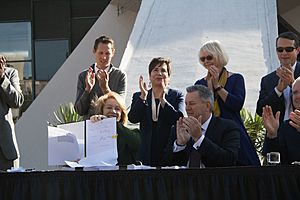
The arena closed in October 2018 for the renovation. The WNBA's Seattle Storm played their games at other venues during this time. The NHL Board of Governors approved a new hockey team for Seattle in December 2018. This team became the Seattle Kraken.
The project cost grew to over $825 million. The old KeyArena name was retired. The project was called the Seattle Center Arena for a while.
On June 25, 2020, Amazon bought the naming rights. They named it Climate Pledge Arena. This name promotes Amazon's "Climate Pledge." It encourages companies to become carbon neutral by 2040. The arena itself is designed to be very eco-friendly. It uses rainwater for its ice and aims for zero waste.
The rooftop sign for KeyArena was removed in July 2020. The new Climate Pledge Arena sign was put up in December 2020. The arena's roof was held up by temporary supports while the inside was rebuilt.
Climate Pledge Arena officially opened on October 19, 2021. The first event was a concert by Foo Fighters and Death Cab for Cutie. The Seattle Kraken played their first game there on October 23, 2021. The Seattle Storm played their first game in the redeveloped arena on May 6, 2022. In 2025, PWHL Seattle will begin playing here.
Exciting Events
Sports Action
Climate Pledge Arena hosts many exciting sports events.
- It has held several UFC (mixed martial arts) events.
- The arena hosted early rounds of the NCAA Division I men's basketball tournament in 1999 and 2015. It will host again in 2025.
Concerts and Shows
Many famous musicians have performed at the arena.
- The Beatles played there twice in 1964 and 1966.
- Elvis Presley performed in 1970 and 1976.
- Metallica filmed live videos for their 1993 box set there.
- U2 performed in 2005.
- Destiny's Child had one of their last shows there in 2005.
- Beyoncé performed her first solo U.S. show there in 2009.
- Madonna had two sold-out concerts in 2012.
- Bruce Springsteen has played there five times, including a nearly four-hour show in 2016.
- Seattle's own Macklemore and Ryan Lewis played three shows in 2013.
- Foo Fighters and Death Cab for Cutie played the first concert after the renovation in 2021.
- Korean boy group Stray Kids performed in 2022.
Arena Seating
When it first opened, the arena could hold 13,200 people for basketball. It held 12,250 for ice hockey. Over time, small changes were made to add more seats.
In 1995, after the big renovation, the capacity grew. It could then hold 17,072 for basketball and 15,177 for ice hockey. However, some hockey seats had blocked views.
The redeveloped Climate Pledge Arena has a new inside. It can now seat 18,300 for basketball and 17,151 for ice hockey. It can also hold 17,200 for concerts. The record attendance for a basketball game was 18,343 fans in May 2024.
Here's how the seating capacity has changed over the years:
|
|
Cool Features and Amenities
The new Climate Pledge Arena is huge, covering 740,000 square feet. Most of its lower seats are actually underground! The main entrance, called the Alaska Airlines Atrium, is at ground level.
The arena has special six-sided scoreboards hanging from the ceiling. They are placed high up so everyone can see the game clearly. Many food stands use Amazon One for easy, contactless payments.
Climate Pledge Arena is very focused on being eco-friendly. It aims to be a "net-zero" building. This means it tries to have no negative impact on the environment.
- All events aim to be "zero-waste," using compostable containers.
- They collect rainwater to make the ice for hockey games.
- At least 75% of the food served comes from local farms.
- Fans with a ticket can get a free public transit pass. This pass works for two hours before and after an event. This helps reduce traffic and pollution.
Getting to the Arena
Climate Pledge Arena is in the Lower Queen Anne neighborhood. It's easy to get there using public transportation.
- King County Metro buses serve the area from many parts of Seattle.
- The Seattle Center Monorail connects the arena to downtown Seattle. It runs more often during events.
There are also three public parking garages near the arena. They can hold almost 3,000 cars. Other parking lots and street parking are also available. The arena is close to major roads like Interstate 5 and State Route 99.
In the future, Link light rail service will also reach the Seattle Center. This is planned to start in 2035.
See also
 In Spanish: Climate Pledge Arena para niños
In Spanish: Climate Pledge Arena para niños
- List of NCAA Division I basketball arenas



